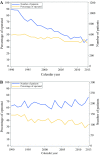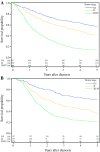Survival Trends in Gastric Adenocarcinoma: A Population-Based Study in Sweden
- PMID: 29987609
- PMCID: PMC6097732
- DOI: 10.1245/s10434-018-6627-y
Survival Trends in Gastric Adenocarcinoma: A Population-Based Study in Sweden
Abstract
Background: Gastric adenocarcinoma is the second most common cancer-related death globally. Assessing survival trends can help evaluate changes in detection and treatment. We aimed to determine recent prognosis trends in gastric non-cardia and cardia adenocarcinoma in an unselected cohort with complete follow-up.
Methods: Population-based nationwide cohort study, including 17,491 patients with gastric non-cardia adenocarcinoma and 4698 with cardia adenocarcinoma recorded in the Swedish Cancer Registry in 1990-2013 with follow-up until 2017. Observed and relative 5-year survival was calculated and stratified by resectional surgery and no such surgery. Prognostic factors were evaluated using multivariable Cox regression.
Results: The relative overall 5-year survival remained stable at 18% for gastric non-cardia adenocarcinoma throughout the study period and increased from 12 to 18% for cardia adenocarcinoma. Concurrently, the proportion of patients who underwent resectional surgery decreased from 49 to 38% for non-cardia adenocarcinoma and from 48 to 33% for cardia adenocarcinoma. The relative postoperative 5-year survival increased from 33 to 44% for non-cardia adenocarcinoma and from 21 to 43% for cardia adenocarcinoma, whereas in nonoperated patients it decreased from 3 to 2% in non-cardia adenocarcinoma and increased from 3 to 5% in cardia adenocarcinoma. Poor prognostic factors were higher tumor stage, older age, and more comorbidity.
Conclusions: Despite decreasing resectional rates, the 5-year overall survival has remained unchanged for gastric non-cardia adenocarcinoma and improved for cardia adenocarcinoma over the last two decades in Sweden and is now similar for these sublocations. The postoperative survival has improved for both sublocations, but particularly for cardia adenocarcinoma.
Figures



Comment in
-
ASO Author Reflections: Survival Trends in Gastric Adenocarcinoma.Ann Surg Oncol. 2018 Dec;25(Suppl 3):723-724. doi: 10.1245/s10434-018-6844-4. Epub 2018 Oct 8. Ann Surg Oncol. 2018. PMID: 30298317 Free PMC article. No abstract available.
References
MeSH terms
LinkOut - more resources
Full Text Sources
Other Literature Sources
Medical

